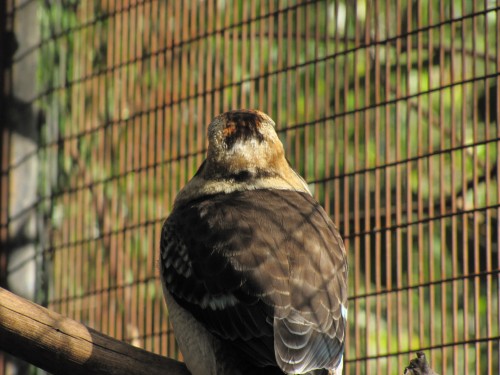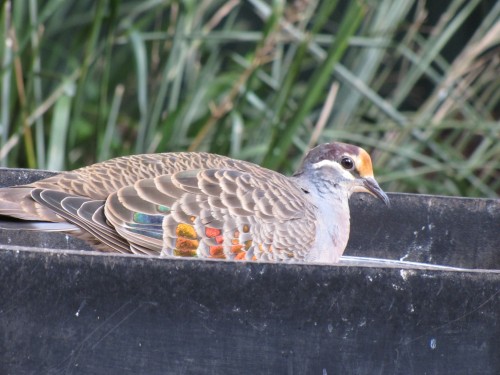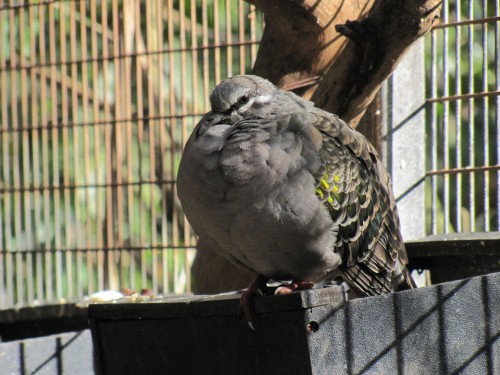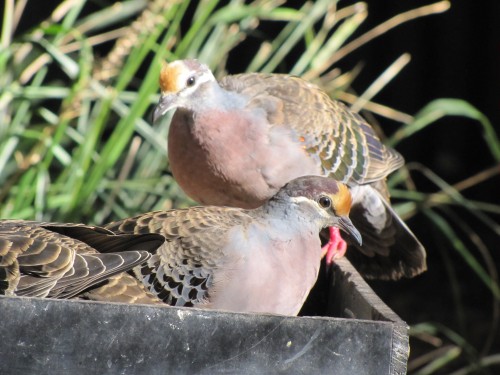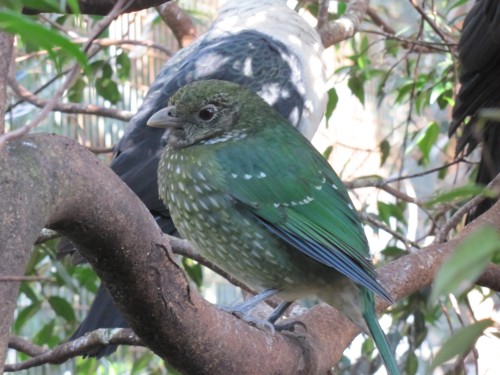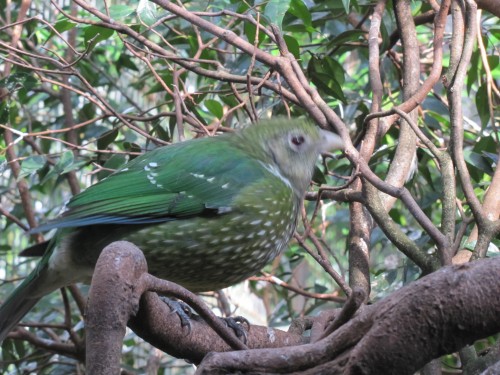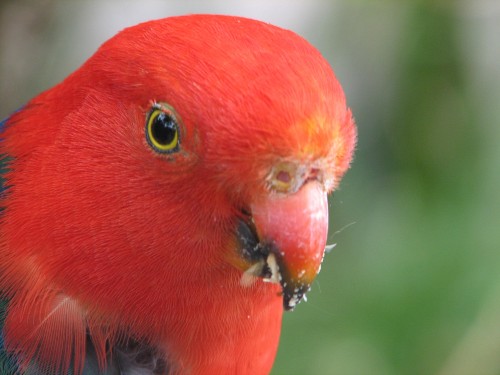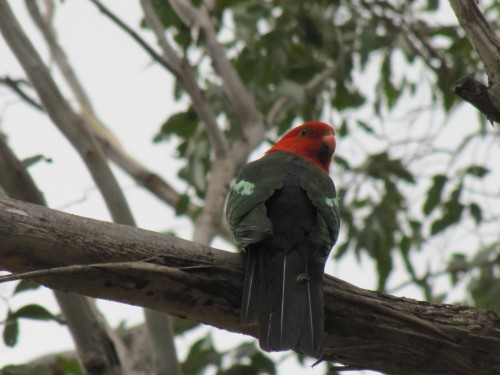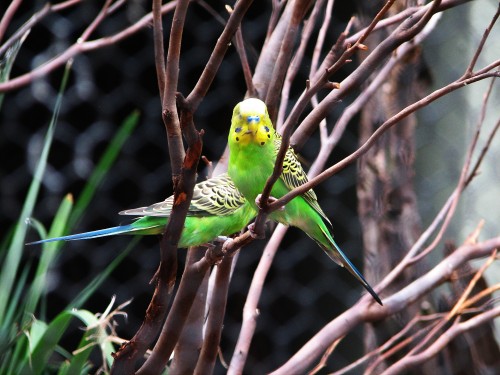A rude Laughing Kookaburra
Most people love to hear the call of the Laughing Kookaburra. It is one of the quintessential bird calls of the Australian bush.
Some people might be of the opinion that Laughing Kookaburras can be quite rude when they laugh at inappropriate moments. The bird in the photo above was being rude in a quite different way; he turned his back on me.
The bird shown in the photo today was one of the residents of one of the walk through aviaries at the Australian Reptile Park near Gosford north of Sydney. We went there on a family outing recently. It is my guess that there were also many more kookaburras in the surrounding bushland.
I’d better own up. The bird in the photo did turn around shortly after this photo was taken. Unfortunately I didn’t get the focus right and it turned out quite blurred, so I guess you can say that I was the rude one – for calling it rude in the first place!
Bronzewing Pigeons at the Australian Reptile Park
The Common Bronzewing Pigeon is a widespread species in the mallee areas of South Australia where I live, as well as being relatively common throughout its range where suitable habitat exists. It is scarce in the drier parts of the continent.
The photos shown in today’s post were taken on a recent family visit to the Australian Reptile Park near Gosford north of Sydney. These birds were not wild birds but individuals kept in one of the aviaries there. I feature them here because of their beautiful colours.
The bird immediately below this text is not as colourful. It could be a juvenile, or the lack of colour could be the angle of the sun on the feathers. It looks more fluffed up than normal; it was a very cold day.
The prominent yellow-buff colouring on the males in the top and bottom photos is particularly striking, something I haven’t observed in the natural environment. In their natural habitat they tend not to sit nicely like these in one of the walk through aviaries in the reptile park. I usually just see a blurred shape of a bird fast disappearing into the distance.
Green Catbird at the Australian Reptile Park
The Green Catbird is a species I have only seen on a handful of occasions in the wild. The bird shown in the photo above was taken in one of the walk-through aviaries at the Australian Reptile Park near Gosford, north of Sydney. We recently visited the park on a family outing with our grandchildren.
The Green Catbird gets its name from its cat-like call. The green part of the name is obvious! The species is one of two catbirds in Australia, the other being the Spotted Catbird which lives in far north coastal Queensland, a species I have yet to see. Green Catbirds on the other hand are found along coastal areas of southern Queensland and eastern New South Wales.
Catbirds inhabit rainforests where they feed on fruit. They are known to raids fruit trees in orchards and gardens.
Happy New Year
Where has the time gone?
I was just getting over Christmas and then WHAM! New Year hits us and now I find that a week – a whole week – of 2014 has gone by without me wishing all my readers a Happy New Year.
Disgraceful.
Someone please slow down the clock – or add another month or two to the calendar. I need an extra few weeks/months in every year to get done the things I plan to do.
Many years ago I had a Calvin & Hobbes cartoon pinned up near my desk at work. The caption read: “God put me on Earth to achieve a certain number of things. Right now I’m so far behind I am going to live forever.” I feel that way right now – and have frequently felt it over recent years.
So with no further ado, let me wish all of my readers a HAPPY NEW YEAR.
One of the hindrances to not sharing anything new here recently has been the peaceful passing of my mother-in-law. It has meant a flurry of activity, including a rushed trip home from Sydney where I’d hoped to have been out birding a little more. Mum’s funeral was a celebration of the great things about her – not the hardships and ill health of recent years. It was also a time of gathering together family and friends to remember the good times with much laughter.
What about the birds?
Good question.
I’d better get around to telling you about the birds I’ve seen recently. One species I longed to see in my son’s garden in Artarmon was a King Parrot. Even my 5 year old grandson can identify that one because it is a frequent visitor to the garden. Sadly none made an appearance while I was playing with the children during our three week stay.
King Parrot
On a brighter note I did see about 4 Australian King Parrots during our day-long visit to Mt Annan Botanic Gardens at Campbelltown in the south of great Sydney. The light conditions were poor – very overcast – when I tried to photograph them, and the photo below is the best of a poor lot. At least you can see that it is, indeed, a male King Parrot.
The photo at the top of this page is one of my favourites and was taken in one of the walk-through aviaries at Adelaide Zoo here in South Australia.
Beautiful Budgerigars
I am quite pleased with this photo of two budgerigars. It was taken through the wire netting of one of the aviaries in the Adelaide Zoo here in south Australia. The viewer is not even aware of the netting between my camera lens and the birds.
Budgerigars, probably the most kept pet bird in the world, is truly magnificent in its natural colours and in its natural environment. I know breeders of this species have developed all sorts of amazing colour variations: yellow, blue, purple, white, speckled and even red – though I suspect the photo of a red one I found online was actually of a bird dyed that colour.
My question is: WHY?
Why mess with beauty and perfection. The natural colours are just perfect.
Rant over.
